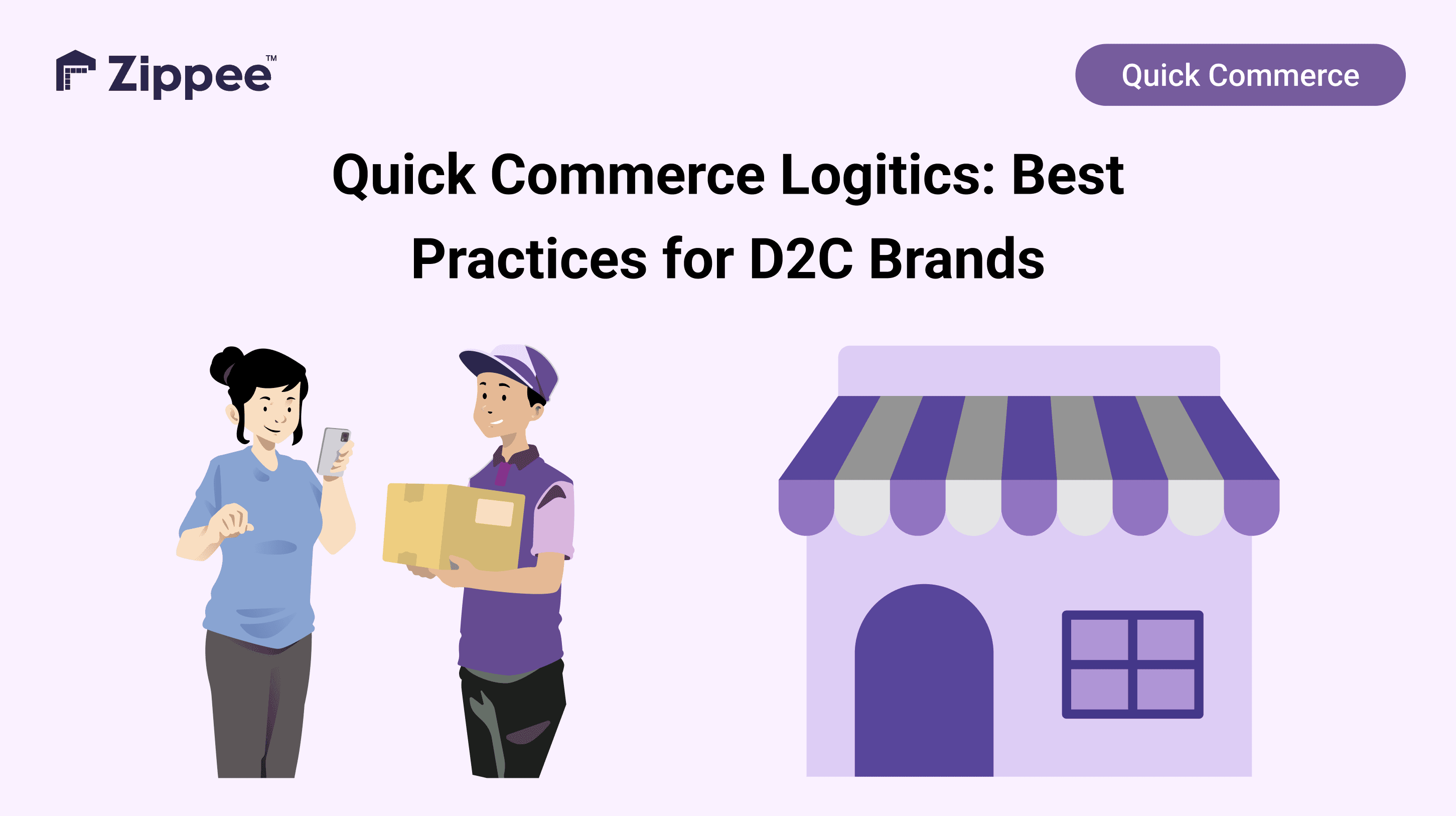
A Guide to Quick Commerce Logisitcs for D2C Brands :
In today’s fast-moving ecommerce landscape, quick commerce shipping is no longer optional—it’s critical infrastructure. With delivery windows of 10 to 120 minutes, it’s designed for urban, digitally native consumers who expect instant fulfilment.
For D2C operators, CPG leads, and ecommerce managers, this marks a shift from speed as a feature to speed as a supply chain strategy.
India’s quick commerce market is set to reach $5.5 billion by 2025 (RedSeer), growing at a 15x CAGR. Brands that can’t meet <2-hour delivery SLAs risk churn, lost relevance, and lower LTV.
This piece breaks down what quick commerce logistics entails and how partners like Zippee help brands deliver speed without sacrificing control or efficiency.
How Quick Commerce Differs From Traditional Ecommerce Shipping
6 Best Practices for Brands to Build & Scale Quick Commerce Logistics
1. Decentralised Fulfilment Network with <3km Coverage Radii
Brands must move beyond zonal warehouses and into city grids. Coverage density, not warehouse size, becomes the KPI. With Zippee, brands connect to a 200+ dark store network across top metropolitan areas, fully API-integrated for seamless demand synchronisation.
Tip: Avoid single-node dependencies. Use data to rotate high-volume SKUs across overlapping radii for redundancy.
2. Real-Time Inventory Sync Across Nodes
Forget daily SKU reports, latency kills SLAs. Your OMS and WMS must be integrated with every dark store node for live orderability. Zippee’s system utilises a node-level stock ledger that is updated with each transaction.
Stat: According to Shopify+, brands using real-time inventory sync reduce out-of-stock cancellations by up to 27%.
3. AI-Optimised Last-Mile Delivery & Allocation
Quick commerce isn’t just faster routing—it’s intelligent orchestration. Allocation must factor:
- Rider ETA vs. SLA clock
- SKU size → vehicle match
- Real-time traffic/weather conditions
- Location heatmaps by hour/day
Zippee’s AI platform dynamically assigns orders within <60 seconds, reducing rider idle time by 30–40%.
4. SKU Rationalisation & Data-Led Merchandising
Quick commerce is not built for endless aisles. You must identify top velocity SKUs based on repeat frequency, time-of-day demand, and geographic dispersion.
Use case: A leading FMCG brand using Zippee saw 34% higher conversion on a 280-SKU curated Q-comm catalogue vs their full catalogue on traditional ecommerce.
5. Service Quality Layer: Visibility + CX
Urban Q-comm consumers are unforgiving—any disconnect in order status, ETA, or substitution can tank retention. Embedding:
- Live order tracking
- Proactive alerts
- Slotless delivery ETAs
- Single-window CX support
…is a must. Zippee delivers this as a white-labeled layer.
6. Measure and Manage Unit Economics
Quick commerce isn’t inherently margin-negative, but it can be. Track per-order cost (rider, warehousing, picking, returns, packaging) and introduce:
- Auto-routing logic to reduce distance
- Time-of-day dispatch pricing
- Bundling promos (2-in-1 delivery logic)
Zippee reduced last-mile delivery costs by 21% for a beverage brand by shifting high-volume orders to fixed-window 2-hour slots with micro-clustering.
How Zippee Powers High-Performance Quick Commerce Logistics
Zippee is not a courier; it’s a Q-comm infrastructure partner purpose-built for D2C and ecommerce brands scaling in metros.
Key Differentiators:
- Dark Store Infra: 150+ ready-to-integrate micro-fulfilment nodes
- Order-Aware Dispatch Engine: Machine learning-based ETA mapping + fleet assignment
- Real-Time Inventory Sync: API hooks with ERP, WMS, OMS platforms
- White-Labeled CX: Real-time tracking + branded support
- 60-min & 120-min Modes: Flexible SLAs with KPI-level tracking
Outcomes Delivered:
- 25% reduction in fulfilment cost per order
- 99.1% SLA adherence (avg. across Tier 1 cities)
- 32% increase in order rerun rate for FMCG clients
- Seamless scale to 10+ cities in <30 days
Related Resources
- Top Quick Commerce Logistics Partners for D2C Brands in India (2025)
- Mistakes to Avoid in Quick Commerce Logistics
Conclusion
For forward-thinking ecommerce and D2C leaders, quick commerce logistics is not about chasing speed; it’s about owning the proximity advantage. In a high-density, high-demand environment like India’s metros, sub-hour fulfilment drives not just conversion, but retention, LTV, and competitive moat.
Zippee offers the infrastructure, intelligence, and integration layer to help your brand not just deliver faster, but deliver smarter, sustainably, and at scale.





.png&w=256&q=75)













